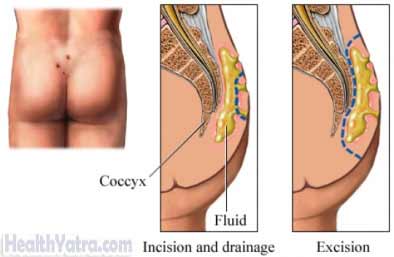Definition
A boil is a red, swollen, painful bump under the skin that is caused by an infection. Boils often start in an infected hair follicle. Bacteria form an abscess or pocket of pus. With time, the pus may come to a head and drain out through the skin. Boils can occur anywhere, but common sites include the face, neck, armpits, buttocks, groin, and thighs.
There are several types of boils:
- Furuncle or carbuncle—an abscess caused by the bacteria Staphylococcus aureusor Streptococcus pyogenes, sometimes occurs as several boils in a group
- Pilonidal cyst—an abscess that occurs in the crease of the buttocks and almost always requires medical treatment
- Cystic acne—an abscess that occurs when oil ducts become clogged and infected, more common in the teenage years
- Hidradenitis suppurativa—an uncommon disorder where multiple abscesses occur in the armpit and groin area

Causes
Causes of boils may include:
- Bacteria, including Staphylococcus aureus
- Ingrown hair
- Splinter or foreign object lodged in the skin
- Blocked sweat gland or oil duct
Risk Factors
Factors that increase your risk of getting a boil include:
- Diabetes
- Poor nutrition
- Poor hygiene
- Weakened immune system
- Exposure to harsh chemicals
Symptoms
Symptoms may include:
- Skin lump or bump that is red, swollen, and tender
- Lump that becomes larger, more painful, and softer over time
- A pocket of pus that may form on top of the boil
Diagnosis
The doctor will ask about your symptoms and medical history and perform a physical exam. A bacterial culture of the boil may be taken.
Some boils do not need medical attention and may drain on their own. More serious symptoms from boils may require treatment. These include:
- The boil worsens, continues, or becomes large or severe
- You have a fever
- The skin around the boil turns red or red streaks appear
- The boil does not drain
- An additional boil or boils appear
- The boil limits your normal activities
- The boil is on your face, near your spine, or in the anal area
- You have diabetes
- You develop many boils over several months
Treatment
Your doctor can drain the boil if needed and treat the infection with antibiotics.
Home treatment may include:
Warm Compresses
Apply warm compresses to the boil for 20 minutes, 3-4 times a day. Depending on the area of the body affected, you may be able to soak the boil in warm water. These measures can ease the pain and help bring the pus to the surface. Repeated soaking will help the boil begin to drain.
Lancing the Boil
Do not pop or lance the boil yourself. This can spread the infection and make it worse. If the boil does not drain on its own or it is very large, you may need to have it drained or lanced by your doctor.
Cleaning and Bandaging
Whether the boil drains on its own or was lanced by a doctor, you must keep it clean. Wash it with antibacterial soap and apply a medicated ointment and bandage. Clean the affected area 2-3 times a day until the wound heals completely.
Prevention
To help prevent boils:
- Practice good hygiene. Wash boil-prone areas with soap and water or an antibacterial soap. Dry thoroughly.
- Clean and treat any minor skin wounds.
- Avoid clothing that is too tight.
